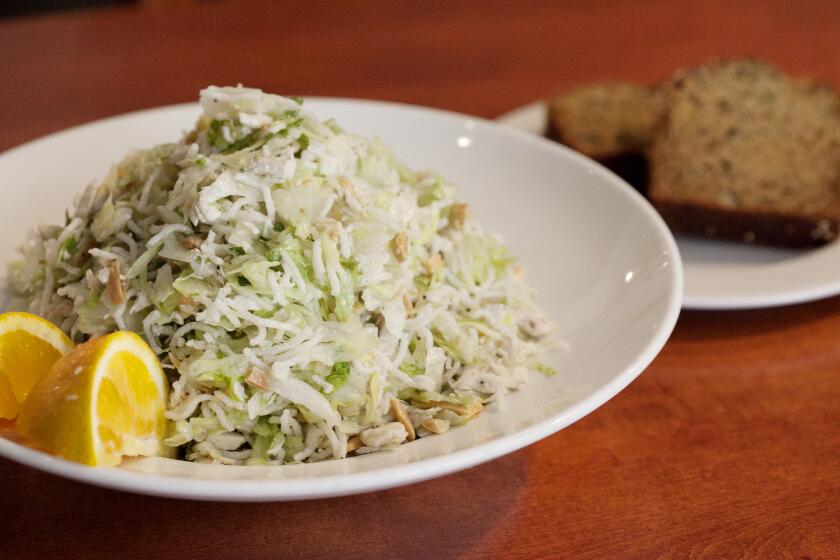Meat on a stick
The original shish kebab, they say, was broiled over campfires on Turkish nomads’ swords.
Oh, sure. Give me a break. A nomad warrior, whose life depended on his razor-sharp blade, would ruin the temper of his sword’s steel by sticking it in a fire, just to make lunch? In reality, shish kebab must have been invented many times in many places, whenever it occurred to somebody that you could cook little bits of meat without burning your fingers if you impaled them on something long and sharp, like a stick.
Traditional nomads don’t even eat much shish kebab. Most of the year, they scarcely eat meat at all because they’re saving their flocks to sell in town. So when an occasion comes for cooking meat--like entertaining an honored guest--they’re inclined to do it big-time. Bedouins will roast a lamb whole and serve it with mountains of buttered rice.
We probably think of shish kebab as nomad food because of its Near Eastern associations. At the time of the Crusades, Europeans tended to cook large hunks of meat, even whole animals, on large rotating spits, but the Saracens mostly cooked smaller pieces on little skewers. (The reason had a lot to do with the fact that small pieces of meat cook faster. Firewood was more expensive in the Near East than in forest-covered Europe.)
Nice though large hunks of meat can be, shish kebab is more responsive to marinating, so the variations are endless. Marinades make the difference between the rustic comforts of Afghanistan, the heady elegance of Iran, the herb-mania of the Caucasus and the perfumed spiciness of North Africa.
Although there are lots of regional styles, certain shish kebab motifs show up over and over everywhere from Morocco to India. Garlic or onion marinades. A garnish of raw onion sliced paper-thin, often mixed with sliced tomatoes. Fresh herbs. A pita full of shish kebab topped with sliced onions and cilantro. These could come from just about anywhere in the shish kebab zone.
In the Middle Ages, the Arabs liked sweet-and-sour marinades--say, vinegar, raisins and pomegranate juice--although a lot of their shish kebabs were simply rubbed with garlic and oil, perhaps with a few flavorings like mint and coriander.
To judge from medieval cookbooks, the preferred cooking method was to stick the skewers in a tandoor oven, like an Indian tandoori kebab, rather than cooking over a brazier of glowing charcoal in the back-yard barbecue style, which is how shish kebab is more usually cooked today. One reason was that medieval Arabs liked to put a pan of rice pudding on the floor of the oven to catch the juices from the broiling meat.
*
A 13th-Century cookbook gave some quaint instructions for cooking chicken this way if you didn’t have a tandoor. You were supposed to “excavate” a hole in the wall of your house (a brick or stone house, of course) big enough to build a charcoal fire, then stick your chicken in front of it to cook. This way, you could catch those juices in your pan of rice pudding. (But hey, don’t try this at home.)
Sometimes medieval cooks would put a skewer of meat in a pot and seal the lid, making a sort of Dutch oven, and stick the whole business in a tandoor. Then they started putting the meat in the pot without a skewer, and eventually there were a lot of dishes called kebabs that were actually stewed or even fried. This was particularly true in Turkey, which has dozens of non-grilled dishes with names like tas kebabi and islim kebabi , so the Turks coined the term sis kebabi (skewer kebab) to refer to the old-fashioned kind.
In many places, shish kebab is just pieces of meat on a skewer, perhaps alternating with bits of lamb fat. What most of us think of as full-scale shish kebab--meat alternating with cherry tomatoes and pieces of onion and bell pepper--is the Turkish sis kebabi or Greek souvlaki . In Istanbul, the meat is cut in fairly small pieces ( kusbasi , “the size of a bird’s head”) and marinated in onion juice and a little oil, perhaps with some bay and thyme. Greek cooks are a little more likely to use a garlic and wine or lemon juice marinade and such louder herbs as rosemary.
Shish kebab is mostly a street food. You take a flat bread in your hand like a washcloth and strip the meat off the skewer with it, and presto--there’s your sandwich. The Turks consider it a mere snack and wouldn’t dream of serving it to a guest as a main course.
But Turkey, particularly the southern part of the country, has a number of fairly elaborate shish kebabs that are served on plates. First there’s a layer of pita, then a layer of meat, then various garnishes. One variety comes with peppers, onions, tomatoes and yogurt sauce. Another, made from spicy marinated meat alternating on the skewer with slices of eggplant, is topped with tomatoes, onions, parsley and the sour spice sumac.
On the other hand, the usual Lebanese kebab (known as lahm mashwi ) has a purist simplicity, often marinated in nothing but allspice and olive oil--plus cinnamon, if you want to get racy. It can be very satisfying served in a Lebanese mountain coffeehouse with pita, hummus, crunchy pickled turnips and a bowl of yogurt.
Kebab is likely to be very simple in Central Asia, too, merely rubbed with garlic and the caraway-like local variety of cumin. In Central Asia and Afghanistan, kebabs can be cooked in tandoor ovens, but there are also street vendors who cook it on sheet metal braziers 10 inches wide and three feet long that can hold 30 or 40 skewers at once.
Egypt is not particularly known for kebabs because it’s a such a poor country--the national dish is plain boiled fava beans. However, there is a famous chain of shish kebab parlors in Cairo called Abu Shakra, where your order comes with sharp tahineh sauce (made with vinegar instead of lemon juice) spiked with red peppers and dill.
North Africa is another story. Skewers of peppery qudban are a classic street food there, eaten with a tortilla-like flat bread called kesra .
Lamb and chicken are the usual meats throughout the shish kebab zone; the beef is often unsuitable for grilling because it comes from working oxen, dairy-type cattle or even water buffalo, and pork is out of the question for Muslims. But the Bulgarians, Serbs and Croatians often make smoky, oniony kebabs of pork (or veal). The same is true of the Georgians and Armenians, and pork goes particularly well with their sweet-sour pomegranate or plum sauces.
Chelo kebab is one of the most sophisticated grilled meat dishes, with an aristocratic whiff of saffron in its onion juice marinade. It’s associated with Iran today but actually originated near the Caucasus. The young prince Naser od-Din was raised in the Azerbaijani-speaking part of Iran, where chelo kebab was a traditional dish. When he was crowned in 1848, he insisted on having a chelo kebab maker next to the palace, ensuring its fashionability. Everybody wanted to eat like the shah.
Nomad swords, indeed. Give me a break.
AFGHAN CHICKEN KEBAB
This simple marinade has two benefits, apart from its fine tart flavor. Lactic acid from the yogurt tenderizes the chicken breast until it’s positively fluffy, and as it cooks, the yogurt forms a bit of crust that keeps the meat from drying out so fast. The Afghans also marinate lamb in this yogurt and garlic mixture.
1 cup yogurt
1 1/2 teaspoons salt
1/2 teaspoon ground red or black pepper
3 cloves garlic, minced fine
1 1/2 pounds boneless, skinless chicken breasts, cut in kebab pieces
Flatbread like lavash, pita or large flour tortillas
3 tomatoes, sliced
2 onions, sliced
Cilantro
2 lemons or 4 limes, quartered
Mix yogurt, salt, pepper and garlic in bowl. Mix meat with yogurt and marinate 1 to 2 hours at room temperature, up to 2 days refrigerated.
Thread meat on skewers and grill over barbecue. Place bread on plates (if using tortillas, toast briefly over flame), divide meat among them, top with tomato, onion slices and cilantro and fold bread over. Serve with lemon or lime quarters for squeezing.
Makes 4 servings.
Each serving contains about:
423 calories; 841 mg sodium; 81 mg cholesterol; 8 grams fat; 46 grams carbohydrates; 39 grams protein; 1.27 grams fiber.
IRANIAN CHELO KEBAB
Fresh onion juice gives this marinade a richer aroma than chopped onions can, and without the coarseness of onion flesh. The saffron makes it elegant, but if you can’t get saffron, substitute 2 teaspoons ground cumin and 2 tablespoons ground coriander. Made with saffron, this marinade is also excellent with chicken and fish.
Chelo is a plain rice pilaf but very buttery and made so that a crunchy golden crust forms on the bottom of the pot. It’s traditional to offer this crust to your guest and to sprinkle some sour ground sumac berries (available in Near Eastern markets and not related to poison sumac) over the dish.
CHELO
1 3/4 cups fragrant long-grain white rice such as basmati
Water
Salt
1/3 cup melted unsalted butter
Rinse rice in three changes of lukewarm water. Soak rice in cold water to cover with 1 1/2 tablespoons salt 1 hour.
Put 2 quarts water in pot, add 1 tablespoon salt and bring to boil. Drain soaked rice and add to boiling water. Boil until rice is nearly done but not soft, 5 to 10 minutes, stirring twice to keep grains from sticking together. Drain rice in colander and rinse with lukewarm water.
Put 1/3 of melted butter and 2 tablespoons water in bottom of pot. Using large spoon, sprinkle rice grains into pot, distributing evenly. Allow rice to form cone shape. Pour remaining melted butter over rice, distributing evenly. With handle of wooden spoon, punch 2 to 3 holes from top of rice mound to bottom of pot.
Put dish towel or paper towels over pot, then cover with pot lid. Set pot on medium heat 10 to 15 minutes, then reduce heat to low 35 to 40 minutes. Can be kept in warm oven 1 hour.
KEBAB
1 large onion
1/8 teaspoon saffron
2 pounds boneless lamb or beef, in kebab pieces
Salt, pepper
1/4 cup butter, melted, optional
Cilantro
4 onions, quartered, optional
1 to 2 teaspoons ground sumac, optional
Quarter 1 onion and reduce to fine puree in food processor (leave kitchen windows open because of fumes). Push puree through fine strainer. Grind saffron to powder in mortar, or on plate using back of spoon, and dissolve in onion juice.
Clean meat and trim excess fat. Mix meat with onion juice marinade, cover with plastic wrap and marinate 1 hour at room temperature.
When ready to cook meat, season with salt and pepper to taste and thread onto skewers. Grill until done. Brush with melted butter.
To serve, set Chelo pot in sink of cold water 1 minute to loosen crust on bottom of pot. Remove pot lid. Turn large serving plate upside-down and cover pot with it. Holding pot and plate tightly together, turn both upside-down. Rice should come out on plate.
Remove pot. Divide crust among diners and serve rice with Kebab. Garnish with cilantro and raw onions, and sprinkle kebab with sumac.
Makes 4 to 6 servings.
Each of 4 servings contains about:
658 calories; 780 mg sodium; 151 mg cholesterol; 24 grams fat; 66 grams carbohydrates; 40 grams protein; 0.29 gram fiber.
GEORGIAN PORK KEBAB
There are shish kebab marinades using garlic, pomegranate and cilantro in a 10th-Century Arabic cookbook, although Muslims would never use them on pork. This kebab recipe comes from Sonia Uvezian’s “The Best Foods of Russia,” and the sauce recipe is from “Please to the Table” by Anya von Bremzen and John Welchman. Sour pomegranate syrup is available in Near Eastern markets.
POMEGRANATE SAUCE
1/2 cup bottled Near Eastern sour pomegranate syrup (rob-e anar or dibs rumman--not sweet grenadine syrup), or 1 1/4 cups fresh pomegranate juice
1 small clove garlic, minced
2 teaspoons minced cilantro
Red pepper flakes
Salt
If using fresh juice, put it in non-reactive pan over high heat and boil down to 1/2 cup of syrup, about 15 to 20 minutes. Put pomegranate syrup in mixing bowl. Add garlic, cilantro, red pepper flakes and salt to taste. Stir together.
KEBAB
1 medium onion, grated
1 tablespoon oil
Pomegranate Sauce
2 teaspoons thyme
1 1/2 teaspoons salt
Freshly ground black pepper
2 pounds boneless pork loin, cut in 1 1/2-inch cubes
2 tomatoes
8 green onions
Combine onion, oil, 2 tablespoons Pomegranate Sauce, thyme, salt and pepper in deep bowl and mix well. Add pork and stir until thoroughly coated. Cover and let stand at room temperature 3 to 4 hours, turning pieces 3 to 4 times to keep well moistened.
Cut tomatoes in eighths. Chop green onions, keeping white parts and 2 inches of green tops.
Thread pork on skewers. Grill until cooked through and well browned on all sides. Remove meat from skewers and garnish with tomatoes and onions. Serve with remaining Pomegranate Sauce.
Makes 4 to 6 servings.
Each of 4 servings contains about:
626 calories; 1,051 mg sodium; 122 mg cholesterol; 52 grams fat; 11 grams carbohydrates; 27 grams protein; 0.60 gram fiber.
MOROCCAN QUDBAN
Qudban means “sticks” or “wands.” You expect exotic spices in Moroccan food, so it may be a little surprising that familiar herbs like oregano and bay leaf are also used. This recipe is from “Totally Hot!” by Michael Goodwin, Charles Perry and Naomi Wise. Serve with pita bread and green onions.
1 tablespoon cayenne
Cumin
1/2 teaspoon turmeric
1/4 teaspoon crushed bay leaf
1/2 teaspoon dried oregano
Ground caraway
1 tablespoon lemon juice
2 tablespoons olive oil
1/2 onion, diced small
2 cloves garlic, minced
1 pound boneless lamb, such as leg or shoulder, cut in 3/4-inch pieces
2 tablespoons butter, melted
Salt
Mix cayenne, 1 teaspoon cumin, turmeric, crushed bay leaf, oregano, dash ground caraway, lemon juice, olive oil, diced onion and minced garlic.
Rub lamb with mixture, cover and marinate 1 hour at room temperature or up to 24 hours in refrigerator.
When barbecue is hot, thread meat on skewers and grill 5 minutes. Turn skewers over and brush with melted butter. Grill 5 more minutes and remove from barbecue. Brush with butter and sprinkle with salt and more cumin to taste.
Makes 2 to 3 servings.
Each of 2 servings contains about:
485 calories; 380 mg sodium; 142 mg cholesterol; 35 grams fat; 8 grams carbohydrates; 36 grams protein; 1.12 grams fiber.
More to Read
Eat your way across L.A.
Get our weekly Tasting Notes newsletter for reviews, news and more.
You may occasionally receive promotional content from the Los Angeles Times.


![LOS ANGELES, CA - JUNE 17: [Cody Ma and Misha Sesar share a few dishes from their Persian Restaurant Azizam] on Monday, June 17, 2024 in Los Angeles, CA. (Ethan Benavidez / For The Times)](https://ca-times.brightspotcdn.com/dims4/default/7ffc7f6/2147483647/strip/true/crop/5110x3417+306+0/resize/320x214!/quality/75/?url=https%3A%2F%2Fcalifornia-times-brightspot.s3.amazonaws.com%2F79%2Fdc%2F4d29255545f5b9813315901692bc%2F1459972-fo-azizam-review20-eba.JPG)







